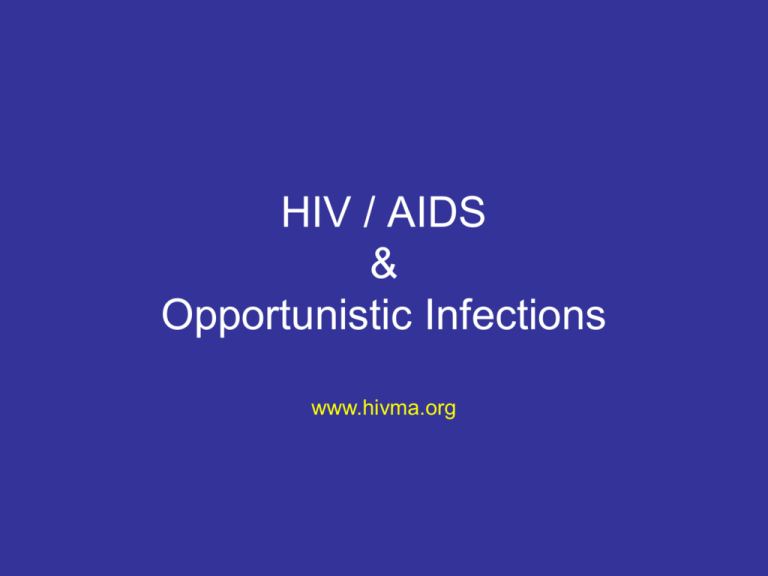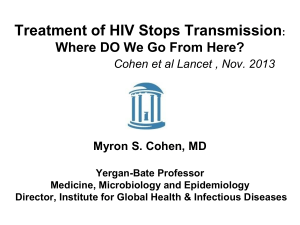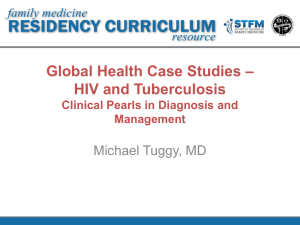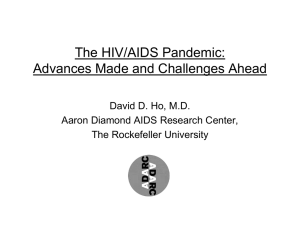HIV / AIDS - Goodsamim.com
advertisement

HIV / AIDS & Opportunistic Infections www.hivma.org Learning Objectives • HIV – the basics • Epidemiology and screening • New diagnosis and prognosis • Antiretrovirals • Opportunistic infections – clinical cases Human Retroviruses HTLV-1 HTLV-2 HIV-1 HIV-2 Adult T-cell Leukemia, HAM/TSP Possible association with HAM/TSP Extremely slow progression to AIDS HIV-1 Group M HIV-1 Group N HIV-2 HIV-1 Group O SIV (Chimpanzee) SIV (Sooty Mangabey) HIV Infection White Blood Cells Lymphocytes T - Lymphocytes CD4+ T – Lymphocytes (Helper) CD4+ T – Lymphocytes CCR5+ (Memory) T-Cell Panel • % CD3 • % CD4 • % CD8 63 4 55 • Normal CD4% • Normal CD4 >30% >450 • AIDS • CD3, Abs • CD4, Abs • CD8, Abs 569 38 494 – – – – CD4 < 200 CD4% < 14% OI Malignancy • Kaposi • NHL • Cervical cancer Who Should Be Tested? • Routine HIV screening for all individuals ages 13-64 in all health-care settings. • At least annual screening for high risk patients: – – – – Injection drug use (sex partners) Persons who exchange sex for money/drugs MSM and sex partners of HIV infected persons Heterosexuals (sex partner) with >1 sex partner since last HIV test • Repeat test before new sexual relationship. HIV Test • Routine HIV ELISA (HIV-1/O/2) - Positive Western Blot • Rapid HIV ELISA - Negative Routine HIV ELISA - Positive Western Blot • Window Period: - Routine HIV ELISA ~3 weeks - HIV Quantitative PCR ~7 days Initial Evaluation of New HIV • • • • • • • • • • • • • • HIV ELISA / WB CD4 count HIV Viral Load CBC w/ diff Comprehensive Chemistry Lipid profile Genotype resistance test Hepatitis A, B, C serologies RPR Toxoplasma serology Testing for GC/Chlamydia TST or IGRA HLA-B*5701 Urinalysis Thrush Genital & peri-anal lesions Pap smear Anal Pap smear (MSM) Lymphadenopathy Skin: KS lesions folliculitis psoriasis Neurologic: peripheral neuropathy neurosyphilis HAND / neuropsych testing Ophthalmologic (CD4 < 50) Prognosis 3-yr probability of AIDS = AIDS defining illness or death, not CD4<200 http://www.aidsinfo.nih.gov/ContentFiles/AdultandAdolescentGL.pdf Natural Course of HIV Infection Primary Infection Seroconversion Intermediate Stage AIDS Plasma HIV RNA 1,000,000 100,000 Plasma RNA Copies 10,000 CD4 Cell Count 10,000,000 1,000 1,000 CD4 Cells 100 200 10 1 4-8 Weeks Up to 12 Years 2-3 Years Opportunistic Infections – CD4 < 200 Oral candidiasis Pneumocystis pneumonia Opportunistic Infections – CD4 < 100 Candida esophagitis Toxoplasma encephalitis Opportunistic Infections – CD4 < 50 Disseminated cryptococcosis Kaposi sarcoma Opportunistic Infections – CD4 < 50 CMV Retinitis Molluscum contagiosum Many other… Disseminated Mycobacterium avium Progressive multifocal leukoencephalopathy Cryptosporidiosis & other protozoa AIDS Defining Illnesses Candidiasis Esophageal Tracheal, bronchial Cervical Cancer, invasive Coccidioides – disseminated Chronic diarrhea (>1 month) Cryptosporidia or Isospora Cryptococcus – extrapulmonary CMV Retinitis Other (not liver, spleen, LN) HSV Chronic ulcer (>1 month) Pulmonary, esophageal Histoplasma – disseminated HIV encephalopathy Kaposi’s sarcoma Lymphoma (NHL) Burkitt’s Immunoblastic Primary CNS Mycobacterium TB – any Other – disseminated/extrapulmonary Pneumonia Pneumocystis Recurrent bacterial (within 1 yr) PML NT Salmonella septicemia, recurrent Toxoplasmic encephalitis Wasting syndrome - HIV MMWR 1992; 41 (RR17) When to Start HAART? DHHS Guidelines 2011 (http://aidsinfo.nih.gov) Antiretrovirals • Nucleoside RTI: Abacavir Didanosine / ddI Emtricitabine / FTC Lamivudine / 3TC Stavudine / d4T Tenofovir Zidovudine / AZT • Protease Inhibitors: (Ziagen) (Videx) (Emtriva) (Epivir) (Zerit) (Viread) (Retrovir) • Non-Nucleoside RTI: Efavirenz Nevirapine Etravirine Rilpivirine (Sustiva) (Viramune) (Intelence) (Edurant) • Entry/Fusion Inhibitor: Enfuvirtide / T20 (Fuzeon) Maraviroc (Selzentry) Atazanavir Darunavir Fosamprenavir Inidinavir Lopinavir/Ritonavir Nelfinavir Ritonavir Tipranavir (Reyataz) (Prezista) (Lexiva) (Crixivan) (Kaletra) (Viracept) (Norvir) (Aptivus) • Integrase Inhibitor: Raltegravir (Isentress) • Combinations: Atripla (Tenofovir + FTC + Sustiva) Combivir (AZT + 3TC) Epzicom (Abacavir + 3TC) Trizivir (AZT + Abacavir + 3TC) Truvada (Tenofovir + FTC) HIV Replicative Cycle ART Basics • General concepts: – Need 3 active agents: (2 NRTI) + (NNRTI or PI or Integrase inhibitor) – Treatment is life-long. Discontinuing ART results in viral rebound. • Goal of therapy – HIV VL < 50 = “undetectable viral load” • ART Resistance – – – – – Baseline resistance Suboptimal medication adherence (90-95% compliance) Suboptimal pharmacokinetics Suboptimal potency of the regimen Resistant strains are “archived” = permanent • Common initial regimens: Atripla (Tenofovir + FTC + Sustiva) - QD Truvada + Reyataz + Norvir - QD Truvada + Isentress - BID Combivir + Kaletra - BID Can We Eradicate Infection? Nature Medicine 2003; 9:853-860 Common adverse reactions • Rash – Any antiretroviral – Mild to severe (SJS) – First 2 months • Nausea/Vomiting – Any antiretroviral – R/O hepatitis – Symptomatic management • Diarrhea – Any, but usually PIs – Symptomatic management • Renal failure – Tenofovir (Truvada/Atripla) – First several months • CNS/Psychiatric – Efavirenz (Sustiva/Atripla) – First several weeks • Drug-Drug Interaction – New prescriptions • Fluticasone, Statins • PPIs – OTC • St. John’s Wort When Should You Stop HAART? • Patient clearly non-compliant (active drug abuse) – not “stopping” and actually “starting” • Severe drug reaction: Abacavir hypersensitivity reaction – fever, rash, GI, and/or pulmonary symptoms within 6 weeks of initiation, association with HLA-B*5701. Lactic acidosis (ddI/d4T>AZT) – malaise, myalgias, non-specific symptoms or critically ill, pancreatitis/hepatitis, elevated serum lactate and acidemia. NNRTI hypersensitivity – occurs within 6 weeks of initiation, hepatitis (fulminant hepatic failure) and/or rash (Stevens-Johnson). Nevirapine hepatotoxicity risk factors: pregnancy, HBV/HCV, CD4 > 250 [F] or CD4 > 400 [M]. HIV-Associated Dyslipidemia Fat Accumulation HIV Lipohypertrophy Increase abdominal fat Dorsocervical fat pad Metabolic Changes Increased Triglycerides Increased LDL Decreased HDL Insulin resistance Case #1 • 31 M with history of HIV presents with fevers and progressive DOE x 3 weeks. • He reports he was diagnosed with HIV about 10 years ago when he developed shingles. He never followed-up and has never been on HAART. • He does not know his last CD4 count or viral load. Case #1 ROS: Physical Exam: 20 lbs weight loss x1 year Night sweats for past month Diarrhea 101.80F 94 110/60 16 Pulse Ox 92% SH: Acquired by MSM Born & raised in Ohio Moved to AZ 2 yrs ago Visits homeless shelters GEN – appears comfortable OP – thrush LUNGS – diffuse crackles ABD – soft, non-tender SKIN – no lesions MS – alert & oriented CXR Laboratory Results • • • • • • • CD3 CD4 CD8 CD3, Abs CD4, Abs CD8, Abs HIV VL 87 9 75 610 64 530 500K Differential Diagnosis? Differential Diagnosis Pneumonia in HIV • • • • • • CAP – Pneumococcus, Influenza Pneumocystis TB Coccidioides Histoplasma Cryptococcus Diagnostic Tests • • • • • • • • • Nasal Influenza swab - negative Blood cultures - negative Urine S.pneumonia antigen - negative Sputum culture - normal flora Sputum AFB smear - negative x3 Sputum fungal smear - negative Induced sputum PCP DFA - negative Serum Cryptococcal antigen - negative Coccidioides ELISA - negative Pneumocystis jiroveci • • • • • Subtle – symptoms for weeks to months 90% with CD4 < 200 or CD4% < 15% CXR findings variable – possibly negative Negative CXR – role of HRCT Diagnosis: – Induced Sputum DFA 50-90% – BAL DFA 90-99% – Transbronchial Bx 95+% Therapy • • • • • PaO2 < 70 mmHg A-a > 35 mmHg Corticosteroids IV TMP/SMX IV Pentamidine • • • • PO TMP/SMX Clinda + Primaquine TMP/Dapsone Atovaquone - Clinical deterioration common within 3-5d of initiation of therapy, particularly in those not receiving corticosteroids. - Treatment failure if no improvement or worsening after at least 4-8d of therapy. Prophylaxis TMP/SMX, Dapsone, Atovaquone, Aero Pentamidine Stop prophylaxis when CD4 > 200 x 3 months 20 Prophylaxis: - Requires QD TMP/SMX, not QMWF 10 Prophylaxis: - CD4 < 200, or CD4% < 14% - History of thrush - AIDS defining illness Pneumonia in HIV • S.pneumoniae remains most common cause. Other organisms = H.influenza, S.aureus, P.aeruginosa. • Give Pneumovax and revaccinate when CD4 > 200. • Pulmonary TB in HIV patients with CD4 > 350 similar to that in non-HIV infected individuals. • Pulmonary TB in AIDS patients – typically no cavitation, appears more like consolidation or diffuse infiltrates. • TB in HIV patients – at higher risk of extrapulmonary disease at all CD4 counts. • AIDS patients and HIV patients with unknown CD4 count presenting with pneumonia Respiratory Isolation. Coccidioides • Common cause of pneumonia in Arizona • • • • • CD4 < 250, past history NOT a risk factor Radiographs – diffuse or focal infiltrates Serologic tests ~60% sensitivity Diagnosis – fungal culture, smear ~40% Disseminated disease frequent: lymph nodes, meningitis, skin Case #2 • 42 M with history of IVDA presents with complaints of intermittent fever, HA, and increasing lethargy over the past 4 weeks. • He is subsequently found to be HIV + with a CD4 count of 23. • He reports having been in and out of jail on several occasions. • Poor historian, appears confused. MRI Brain Differential Diagnosis? Differential Diagnosis CNS Lesions in HIV • • • • • • • • Toxoplasma Encephalitis Primary CNS Lymphoma Bacterial brain abscess Progressive Multifocal Leukoencephalopathy TB Cryptococcus CMV Encephalitis Chagas disease Diagnostic Tests • • • • Blood cultures - negative Serum Cryptococcal antigen - negative Toxoplasma IgG positive, IgM negative LP: 8 WBC (90%L), 64 G, 60 P – Toxoplasma DNA PCR negative – CMV and JC virus PCRs negative – TB PCR negative – Cryptococcal antigen negative Toxoplasma Encephalitis • • • • • 80% have CD4 < 100 95+% Toxoplasma IgG+ ~30% single lesion CSF PCR sensitivity 50% Definitive dx = brain bx • Therapy – 6 wks Pyrimethamine/Sulfadiazine Pyrimethamine/Clindamycin • 10 Prophylaxis (CD4 < 100) DS TMP/SMX QD Pyrimethamine/Dapsone Adapted from http://www.cdc.gov Cryptococcal Meningitis • Majority of cases occur in patients with CD4 < 50. • Classic meningeal symptoms/signs (neck stiffness & photophobia) infrequent. • Disseminated disease common: pulmonary, blood, skin. • Elevated opening pressure > 75% (> 20cm H2O). • Cryptococcal antigen 90+% sensitive (serum & CSF). • Treatment: Ampho B +/- Flucytosine x 2wks Fluconazole Repeated LP for symptomatic elevated ICP Case #3 • 29M diagnosed with AIDS ~2 months ago (Thrush), started on HAART 6 weeks ago. • Presents with acute onset of fever, cough, pleuritic chest pain, and dyspnea. • He looks well despite Temp 102.60F. Exam only notable for L sided bronchial breath sounds. • CD4 count 29 146. CXR CT Chest Laboratory Studies • • • • • • Blood cultures Fungal BC Mycobacterial BC Serum Cryptococcal Ag Urine Histoplasma Ag RPR • LDH 188 • WBC 12.9 (88%N) • • • • • • BAL Bacterial Cx BAL Fungal Cx BAL Mycobacterial Cx BAL PCP DFA BAL Viral Cx BAL Cytology: WBC/RBC, benign bronchial cells • Transbronchial Bx: Bronchial mucosa - crush artifact Diagnosis? • Lymph node biopsy reveals caseating granulomata with rare acid fast organisms • LN Mycobacterial culture - MAC Disseminated MAC • Occurs in advanced AIDS, CD4 < 50. • Vast majority – fevers, weight loss, night sweats, severe anemia (Hct < 25%). • Organ involvement: spleen, LN, liver, intestines, and bone marrow. Lung involvement rare (< 10%). • Diagnosis: – Blood culture – single 90-95%, two 99%. – May take 2-6 weeks to grow. • Treatment: Clarithromycin + Ethambutol +/- Rifabutin • 10 Prophylaxis (CD4 < 50): Azithromycin 1200mg Qwk Immune Reconstitution Inflammatory Syndrome • Paradoxical worsening of clinical or laboratory parameters despite rising CD4 counts and declining viral loads. • Inflammatory reaction to a subclinical infection. • Estimated to occur in 1025% of those initiating ART (weeks to months). CID 2004; 38:1159-66 Summary • HIV – HIV-1/0/2 strains. CD4 T-cell, CCR5 > CXCR4. LN damage. • Epidemiology and screening – About 50,000 new cases / yr. MSM > heterosexual > IVDA. – HIV EIA HIV WB. Check VL for acute retroviral syndrome. • New diagnosis and prognosis – Screen for other STIs. Baseline genotype resistance testing. • Antiretrovirals – Indications: CD4 < 350, AIDS, HIVAN, HBV trmt, pregnancy – Need 3 active agents, strict compliance, lifelong treatment • Opportunistic infections – Primary Prophylaxis: PJP, Toxoplasma, MAC – Cryptococcus, CMV, Cryptosporidia – IRIS – unmasking versus paradoxical





